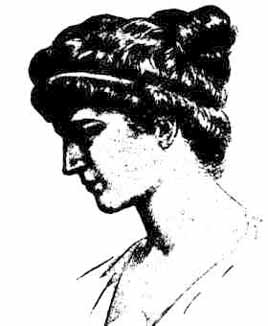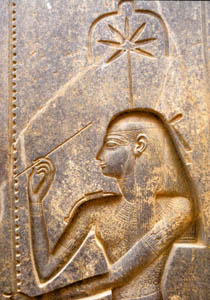Lecture II - Images of Women in LiteratureWeek 2.
In this lecture, we will be looking at the images of women that have persisted through the ages -- defining symbols and models for writers who seek to portray women, and for women, themselves. Please see Announcements Page!! Featured Woman in history of Literature:
Hypatia of Alexandria // 370-415 C.E. Hypatia was brutally murdered by the Nitrian monks who were a fanatical sect of
The second class session will focus on the images of women we find in all cultures. From the ancient "goddess" sculptures of pre-history to the swank and svelte women that grace fashion magazines today, women (like men) have been provided with graphic models of proper appearance - and these models are embedded in modes of behavior and expectations of lifestyle. Be sure to ask questions on the discussion list as we go along! The images of women throughout history and literature seem to represent a kind of universal determination. Ancient goddesses, medieval categories, and modern clichés allow several roles that women can play. We are so familiar with these that we imagine them to be prescriptive: the Virgin, the Temptress, the Mother, the Old Hag, the Little Girl, the Housewife. More recently, we have incorporated another image into the pantheon: the Career Woman. While, of course, there is much truth in the notion that each individual possesses some features of every one of these images at some time in her life, it is passing strange that these images have so little depth. Moreover, in literature, female characters often function at the shallowest of levels with respect to these images. It appears, in retrospect, that woman-as-image was limited to "secondary character" status for many centuries. Announcements: Remember to check the Announcements page for crucial information! Assignment: Short Reports Forum: Discussion List Recommended Reading and Resources Pages: Each lecture will contain several links to interesting and important sites. In addition, I encourage you to visit the Resource Pages for further reading!This week, we begin our examination of our own Images of Women in Literature. When I first began teaching classes in women and women writers, most of them were called something like "Images of Women in Literature" - and the idea was that we were to teach about how women were PORTRAYED in literature by men. This is, of course, a fine thing to examine, but early on, it was almost a necessity. The industry of discovering women writers is now some 30, very productive, years old. But I assure you, my first list of women writers, back in 1973, could fit on one page. No so now!! And, now, we have more than enough women writers to fill ten classes. Still, it is instructive to look at images of women in literature to remind ourselves of the kinds of roles that women have traditionally played in most of the literature anyone read before 1970. As we saw last week, we do not really know the actual participation of women in ancient times, but from the legacy that we have, we can at least speculate on the dominant images of women throughout the ages. The Goddess: But where to start? The image of the Goddess is surely and early one. Seshat, who we looked at last week, was one such Goddess, of the writing type. The image I am using for the course logo is another - one of hundreds of little clay fertility figures found in the archaeological remains of many cultures - she is the Earth Mother. See how many of these categories you have mental images of! (We will be keeping a chart of these, and if you have an image file you would like to add, please e-mail it to me!) The Earth Mother: The Hearth-Keeper: The Hag: The Spinster: The Stepmother: The Governess: The Goodwyfe: The Beauty: The Queen: The Virgin: The Little Girl: The Servant Girl: The Huntress: The Temptress: The Medea:
|
|
Literature 45 - Women in Literature: Marjorie C. Luesebrink, MFA Contents: Announcements // Discussion Page // About Your Class // Class Syllabus // Lecture Notes // Discussion Group // Reading List // Recommended Reading // Assignments // Resources and Web Sites // Grading Policies // Contact Your Instructor
|

 In
the first class we talked a little about Emily Bronte, her image as a
writer, and the Bronte Sisters as models of what we imagine to be the
typical "English" writers. The picture we have for Emily and
Charlotte can be examined in the light of other real men from history and stereotypes of women in literature.
In
the first class we talked a little about Emily Bronte, her image as a
writer, and the Bronte Sisters as models of what we imagine to be the
typical "English" writers. The picture we have for Emily and
Charlotte can be examined in the light of other real men from history and stereotypes of women in literature. ISeshat, Goddess of the Library is one image,
less well known.
ISeshat, Goddess of the Library is one image,
less well known.  Enheduanna, the High Priestess was the first named
author in history.
Enheduanna, the High Priestess was the first named
author in history. 